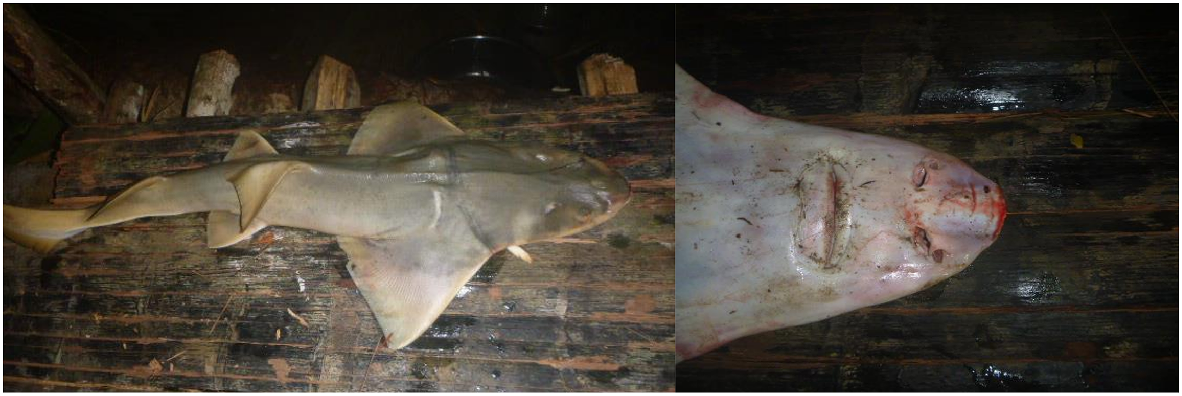An anecdotal observation of an amputee sawfish recapture and development of safe release guide for Papua New Guinea gillnet fisheries
Michael I. Grant A B * , Yolarnie Amepou B , Andrew Chin
A B * , Yolarnie Amepou B , Andrew Chin  A , Sarah J. Hill C , Dana Maggacis C and Madeline Green D E
A , Sarah J. Hill C , Dana Maggacis C and Madeline Green D E
A Centre for Sustainable Tropical Fisheries and Aquaculture and College of Science and Engineering, James Cook University, Townsville, Qld 4814, Australia.
B Piku Biodiversity Network, Waigani Drive, Ensisi Valley, Port Moresby, National Capital District 121, Papua New Guinea.
C Chunky Duck, 11 Kimberly Way, Happy Valley, SA 5159, Australia.
D Centre for Marine Socioecology, University of Tasmania, Hobart, Tas. 7004, Australia.
E CSIRO Environment, Castray Esplanade, Hobart, Tas. 7004, Australia.
Keywords: conservation action, conservation initiative, fish maw, gillnet, Pristidae, rostrum, small-scale fisheries, threatened species interactions.
Sawfishes (Pristidae) are highly threatened, with four species listed as Critically Endangered, and one as Endangered on the International Union for the Conservation of Nature Red List of Threatened Species. Papua New Guinea (PNG) has recently been identified as a sawfish ‘stronghold’ within the Indo-West Pacific (Grant et al. 2021a). However, sawfishes in PNG are vulnerable to small-scale fishers using gillnets to target barramundi (Lates calcarifer) and scaly craoker (local name ‘stone fish’, Nibea squamosa) for the fish maw (teleost swim bladder) trade (Grant et al. 2021a, 2021b). When captured, fishers often amputate the rostrum of sawfish to assist with dis-entanglement, regardless of whether the animal is being retained for consumption, sale, or being released (Grant et al. 2021b). On 28 February 2022, during a fishery monitoring project being conducted in the northern Gulf of Papua, a largetooth sawfish Pristis pristis was captured. The individual appeared to be a recapture that had its rostrum amputated during a previous capture (Fig. 1). At the front of the head, the wound appeared inflamed, red, and bleeding (the wound appears to have been reopened during capture). The individual appeared to be very emaciated, with the vertebral column visible, and the region between the anterior section of the pectoral fins appearing to be thin and indicative of muscle atrophy. The present observation adds to the evidence base that rostrum amputation leads to starvation and eventual death (Morgan et al. 2016).
A juvenile largetooth sawfish Pristis pristis caught with no rostrum in the mouth of the Turama River, southern Papua New Guinea.

In small-scale fisheries in low-income nations, an entangled sawfish can pose a complex scenario for fishers. The rostrum poses a risk to the fisher’s safety during dis-entanglement and the rostrum of a struggling sawfish risks damaging fishing nets. While sawfish ‘safe release guides’ exist, they are tailored to high-capacity western fishery contexts, and often encourage the cutting of fishing gear to dis-entangle the animal (e.g. Queensland Department of Agriculture and Fisheries safe release guide; https://www.daf.qld.gov.au/__data/assets/pdf_file/0005/49109/Sawfish-Guide-Final-Nov-2010.pdf).
Such guides are not appropriate for fishery contexts in low-income nations where gillnets may represent a substantial capital investment by the fishers. In response to this, here we present a sawfish safe release guide developed with advice from local fishers in PNG (available as Supplementary Material). The purpose of this guide is to offer fishers a more appropriate method to release sawfishes of various sizes, that is context specific to the gear used in PNG’s small-scale sector.
Declaration of funding
This study was funded by the Save Our Seas Foundation and the Secretariat of the Pacific Regional Environment Programme (SPREP) By-catch and Integrated Ecosystem Management (BIEM) Initiative of the Pacific-European Union Marine Partnership (PEUMP) Programme, funded by the European Union and the Government of Sweden.
Acknowledgements
The authors thank the Save Our Seas Foundation and the Secretariat of the Pacific Regional Environment Programme (SPREP) By-catch and Integrated Ecosystem Management (BIEM) Initiative of the Pacific-European Union Marine Partnership (PEUMP) Programme, funded by the European Union and the Government of Sweden, for supporting our research in Papua New Guinea. We also thank Kikori fishers, Maxwell Fau Jason, Kemaru Andy Donald, Julien Perry, Ainu and Sasa Eddie, Amos Ivei, and Jeffrey Kimave for their feedback on the sawfish safe release guide.
References
Grant MI, White WT, Amepou Y, Appleyard SA, Baje L, Devloo-Delva F, Feutry P, Ibana D, Jogo DJ, Jogo S, Kyne PM, Mana R, Mapmani N, Nagul A, Roeger D, Simpfendorfer CA, Chin A (2021a) Papua New Guinea: a potential refuge for threatened Indo–Pacific river sharks and sawfishes. Frontiers in Conservation Science 2, 719981.
| Crossref | Google Scholar |
Grant MI, White WT, Amepou Y, Baje L, Diedrich A, Ibana D, Jogo DJ, Jogo S, Kyne PM, Li O, Mana R, Mapmani N, Nagul A, Roeger D, Simpfendorfer CA, Chin A (2021b) Local knowledge surveys with small-scale fishers indicate challenges to sawfish conservation in southern Papua New Guinea. Aquatic Conservation: Marine and Freshwater Ecosystems 31, 2883-2900.
| Crossref | Google Scholar |
Morgan DL, Wueringer BE, Allen MG, Ebner BC, Whitty JM, Gleiss AC, Beatty SJ (2016) What is the fate of amputee sawfish? Essays, Fisheries Magazine, American Fisheries Society. Available at https://fisheries.org/2016/02/what-is-the-fate-of-amputee-sawfish/ [accessed 24 September 2020]


